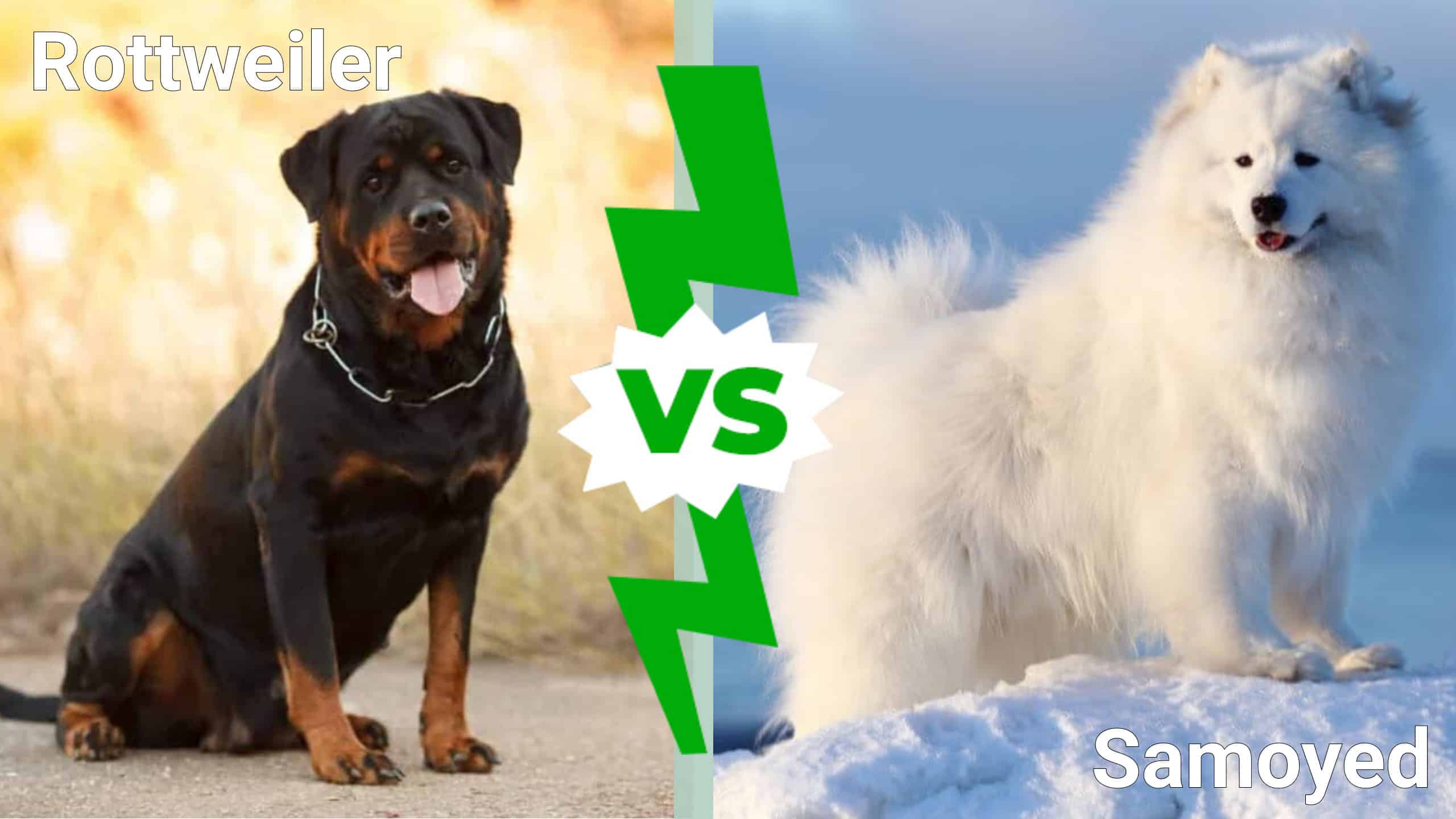Rottweilers and samoyeds are quite different dogs, especially on the outside. However, they do have a few key traits that are similar, which can make selecting the right breed for you pretty challenging.
To help you in this endeavor, we’ve provided a list of differences below to help you decide.
Rottweiler vs. Samoyed: Physical Characteristics

Rottweilers are very large, imposing dogs. This trait makes them very suitable as guard dogs. Of course, they are also quite protective.
©Phillip van Zyl/Shutterstock.com
These dogs are very different visually. Not only are they different sizes, but their coats are strikingly different.
Size
Rottweilers are very robust and powerful dogs. They’re generally put into the large breed category, with adult males weighing as much as 135 pounds. They can get huge, though females are often slightly smaller.
In contrast, samoyeds are medium-sized dogs. Adult males usually reach heights of 21 to 23.5 inches and reach 45 to 65 pounds. They’re much smaller than a rottweiler, which is important to keep in mind.
That said, female samoyeds are about the same size. There isn’t a significant size difference between genders.
Coat Type and Color
Rottweilers have short, dense coats that shed a lot. They practically only come in one coat pattern – black with tan markings. This coat pattern makes them very easy to identify, but it also means there is less variance in the breed to choose between.
On the other hand, samoyeds have a luxurious double coat that originally came about to help protect them from the harsh conditions of the north. It’s very fluffy and soft, which is one reason many people love them. They also practically only come in white and somewhat off-white colors, like cream.
Personality and Temperament

Samoyed puppies are excpetionally fluffy and cute. However, they are a lot of work and tend to be very active – something you need to keep in mind before adopting one.
©iStock.com/Roman Bjuty
Rottweilers and samoyeds also have very distinctive personalities that are fairly different from each other. These traits affect which dog breed may be best for you, as well as each dog’s needs. We recommend carefully looking at each dog’s temperament before deciding to adopt one.
Temperament
Rottweilers are known for being fiercely loyal and protective. It’s their natural instinct to guard those they love and their property, so they often make very good guard dogs. However, this also means that they must be well-socialized, or they can be overly protective.
Along the same vein, these dogs are exceptionally confident. They’re pretty imposing, which is often enough to deter strangers and potential criminals. They’re absolutely willing to stand up to a stranger if they feel threatened.
Samoyeds are pretty different. They’re known for being pretty friendly and sociable. They get along with just about anyone and are not protective, which also means that they don’t need quite as much socialization (though socialization is always important, no matter the breed).
These dogs are also very affectionate and playful. They’re quite people-oriented, which means they love attention. However, they are also pretty active, so they tend to bond through play.
Trainability
Rottweilers are renowned for their trainability. They’re exceptional working dogs and tend to be very obedient, which makes them easy to train. For this reason, they are often used as working dogs in military and police work. Their innate intelligence and obedience make them perfect for these types of jobs.
While their trainability is an asset, these dogs require lots of training. They’re intelligent and bored easily, so training is necessary to keep them entertained and challenged. Otherwise, they can become destructive.
Samoyeds are also intelligent dogs. However, they are very independent and not very obedient. Therefore, while they may understand what you’re saying, that doesn’t mean they will do what you ask them to.
Socialization is essential for Samoyeds to ensure they are well-adjusted and friendly dogs. Early socialization helps them interact positively with people, animals, and different environments.
Rottweiler vs. Samoyed: Needs

In the old days, Samoyeds were the working partners of the Samoyedic people of Siberia who survived by herding and breeding domestic
reindeer
.
©Ilya Barmin/Shutterstock.com
It’s important that a dog fits into your family’s schedule and lifestyle before you adopt one. Considering what the dog needs from you (and whether you can meet those needs) is vital to ensure that they fold nicely into your life.
Exercise
Rottweilers are known for their high energy needs. Therefore, they also require plenty of exercise. They benefit from regular daily exercise, such as long walks, jogs, and agility training. Without sufficient exercise, these dogs can have way too much pent-up energy and become bored, leading to destructive behavior.
Samoyeds are also pretty active, so they also need plenty of exercise. Neither of these dogs is a great option for more sedentary families.
Grooming
Rottweilers have dense, short coats that don’t require significant grooming. However, they do need to be brushed a few times a week. These sessions help reduce the amount of hair they shed, which can help your home be a bit cleaner.
Samoyeds need a lot more grooming, as they have fluffy, long coats. They may be prone to matting. Therefore, they need to be brushed almost every day, which can take a lot of time out of their owners’ days.
Rottweiler vs. Samoyed: Health
Sadly, today, many purebred dogs are not as healthy as they were in the past. Therefore, considering the health of a purebred dog is essential before deciding to purchase one.
Health Problems
Rottweilers are prone to certain issues. Some of these are preventable and treatable, but others are not:
- Hip Dysplasia: This genetic condition is relatively common in Rottweilers. It can lead to joint pain and mobility issues, making regular vet check-ups and monitoring important.
- Heart Conditions: These dogs are also prone to several heart conditions. Dilated cardiomyopathy is somewhat common, so regular vet checkups should include heart checks.
Samoyeds tend to be much less inbred, which also means that they are less prone to many health conditions. However, they are still prone to a few problems.
- Eye Conditions: Like many dogs, Samoyeds are prone to some genetic eye conditions, like PRA. Sometimes, these can be treated, but other times, they can lead to blindness.
Lifespan
Rottweilers live for about 8 to 10 years, which is less than most other breeds. However, these dogs are very large, and large dogs tend to live for a shorter period, anyway.
Samoyeds for a bit longer – 12 to 14 years. They’re purpose-bred, which generally means that they are extremely healthy. Plus, they’re also smaller overall.
Rottweiler vs. Samoyeds: Living Arrangements
Rottweilers and samoyeds live best in certain areas with particular families. They won’t work well for every family.
Rottweilers are adaptable dogs. However, due to their larger size and energy levels, they do best in homes with plenty of space. They need room and play and explore. A fenced-in yard can be very helpful.
They are pretty protective, so they need plenty of socialization and training. Be sure that your canine gets plenty, and you have time to give it to them.
They are excellent family dogs if properly socialized. They get along very well with children, including very small children.
Samoyeds originally came from colder climates, so they still do best in colder climates. They have a thick double coat, so they may not do well in warmer climates.
These dogs are quite sociable. They do well in families, therefore, and they don’t have quite as much socialization as rottweilers.
Samoyeds do best when they have a fenced-in yard to access, as they are exceptionally active. Be sure you have the time to give them the proper exercise, too.
Ready to discover the top 10 cutest dog breeds in the entire world?
How about the fastest dogs, the largest dogs and those that are -- quite frankly -- just the kindest dogs on the planet? Each day, AZ Animals sends out lists just like this to our thousands of email subscribers. And the best part? It's FREE. Join today by entering your email below.
Thank you for reading! Have some feedback for us? Contact the AZ Animals editorial team.








